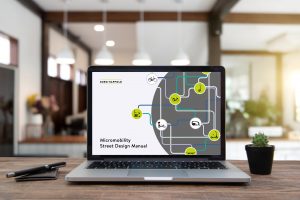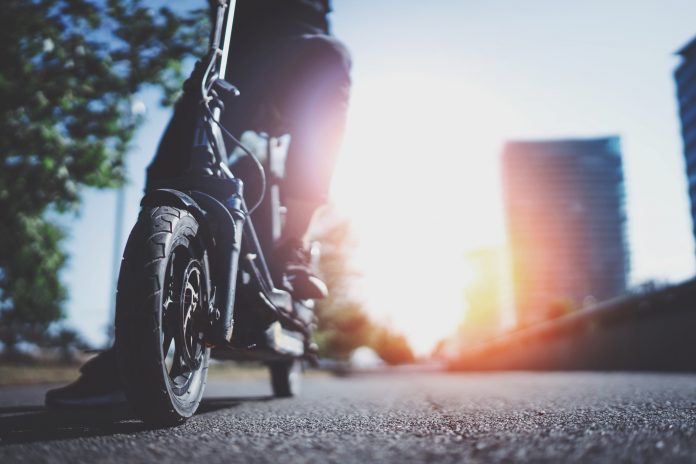Federico Cassani, partner and global director of transport and mobility at engineering consultancy Buro Happold, explores how we can transform urban areas to integrate new micromobility infrastructure and kickstart a new transport revolution
Most of us are now aware of some, if not many, of the emerging types of ways of moving around our towns and cities. E-scooters, in particular, have become increasingly popular. If you’re in one of the selected local authorities that’s trialling a government-backed rentable e-scooter project, you’ll have no doubt spotted the sharp rise in riders on pavements and roads. You may think they’re a nuisance, or you may use them to get around yourself.
Projects like this represent a conscious move to more sustainable forms of transport. The government calls it a “green restart” to local travel, and it’s right we do this to help us decarbonise as quickly as possible.
Micromobility has particular benefits too. Public transport can move huge numbers of people every day, but it’s not always accessible. Where there’s a lack of alternatives, people turn to private cars that contribute to pollution and congestion. Micromobility transport now offers an affordable and green alternative.
But there are challenges we need to overcome to unlock all the opportunities micromobility transport offers. Even if overcome from a legislative and regulatory perspective, the street requirements for these modes are still not fully developed or addressed.
The core issue is that while micromobility transport is already here, our urbans areas have yet to adapt. Our streets for the most part remain designed for the car, and we’re still working to adapt for cycling on a large scale. As cities face a continuous growth in population – it’s predicted that two-thirds of the world’s population will live in cities by 2050 – the question of how to move people around the urban environment is becoming ever more pressing too.
So how do we best embrace the rise in micromobility, and importantly make sure it’s safely integrated in our urban areas? For us as design, engineering and sustainability experts, it means evolving how we plan and build our urban spaces.
Changing how we design our streets

We need to move swiftly to change how we design our streets but understanding how best to do that is complex. That’s why we’ve authored a new white paper called the Micromobility Street Design Manual, sharing our expertise and recommendations. We’re making this available to spark a conversation and stimulate action around designing for micromobility. So, what is this vision?
We can integrate micromobility into existing roads (a quick win) and design a micromobility-focused street that will be an emerging product for the future of transportation. In any new design for urban spaces, we’d look at the feasibility of removing cars from our streets completely. We would also address docking and charging stations for both privately owned vehicles and mobility on demand models, to make micromobility a truly viable system.
Central to our approach is grouping the different types of micromobility transport into categories by speed, usage and braking capability. Lanes can then be created for each category of transport. Electric scooters, push bikes and electric skateboards move faster than hoverboards, roller skates and push scooters, for example. This segregation provides maximum efficiency, safety and comfort for all different modes selected in the same lane.
We’ve taken Camden High Street in London as an example, to illustrate how a street might change and what this could mean for the flow of people. The road is a one-way, mainly residential street. The structure favours motorised vehicles, although the street is home to multiple local shops and restaurants.
By widening pavements, retaining the existing bus lane and exchanging car lanes for three micromobility lanes (see our design graphic in our manual), we can increase the number of people who could travel along the high street from the current peak of 21,400 people per hour, to 60,700 people per hour – a significant increase.
And we can look to technology to unlock further benefits. By including all micromobility vehicles into the category of smart vehicles, for example, the management of junctions and vehicular movements would be revised, allowing for a “green wave” scenario for micromobility instead of cars. The future implementation of autonomous technology within micromobility will also help reduce traffic, encourage ride sharing and establish taxi-like services.
The benefits beyond micromobility
What’s also hugely exciting about micromobility are the benefits beyond being green and accessible. It’s these that also reinforce the case for bringing micromobility infrastructure forward. Evolving transport networks allows change in other elements of society, from ways of living to business and amenities.
Where cars are no longer the dominating mode of transport, there is more space to create greener areas and public breakout spaces. Streets become more welcoming community spaces, with reduced street clutter and signage making them far more open and accommodating to families and the more vulnerable in society.
With more people spending more time on streets, businesses stand to benefit too. And because micromobility infrastructure is relatively inexpensive to create, there are more opportunities to extend transport into other areas, revitalising declining zones or creating new areas for more businesses to operate and succeed in.
What’s next for micromobility?
We would like to see developers and other engineers and designers engage with these proposals and begin the process of designing micromobility into our urban areas. This starts with bringing pilot schemes forward, so we can begin to realise the vision of urban spaces with micromobility at their heart.
We have the ideas and the technology to make all of this, and what we’ve set out in our manual, a reality. It’s now about action.
Federico Cassani
Partner and global director of transport and mobility
Buro Happold
Tel: +44 2079 279 700

















